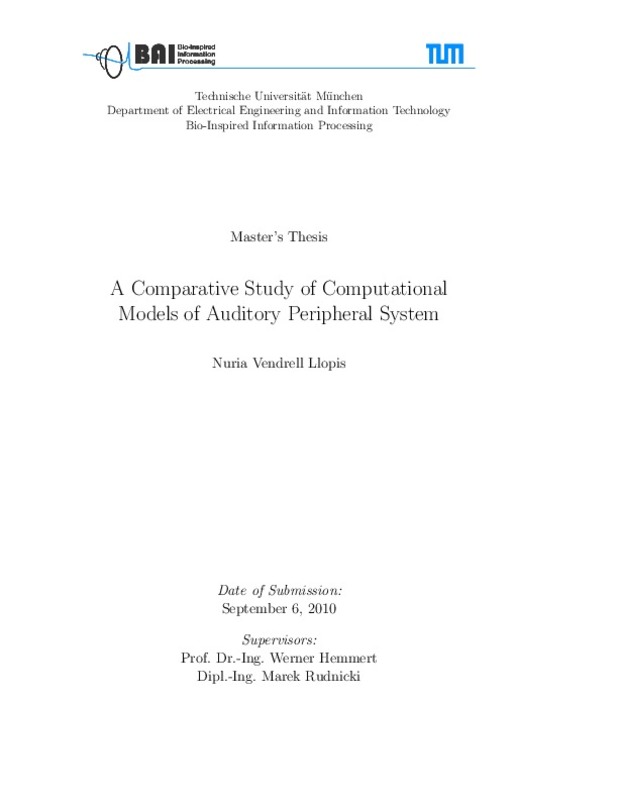JavaScript is disabled for your browser. Some features of this site may not work without it.
Buscar en RiuNet
Listar
Mi cuenta
Estadísticas
Ayuda RiuNet
Admin. UPV
A Comparative Study of Computational Models of Auditory Peripheral System
Mostrar el registro sencillo del ítem
Ficheros en el ítem
| dc.contributor.advisor | Werner Hemmert
|
es_ES |
| dc.contributor.advisor | Marek Rudnicki
|
es_ES |
| dc.contributor.author | Vendrell Llopis, Nuria
|
es_ES |
| dc.date.accessioned | 2013-02-11T12:57:56Z | |
| dc.date.available | 2013-02-11T12:57:56Z | |
| dc.date.created | 2010-09-15 | |
| dc.date.issued | 2013-02-11 | |
| dc.identifier.uri | http://hdl.handle.net/10251/20433 | |
| dc.description.abstract | A deep study about the computational models of the auditory peripheral system from three different research groups: Carney, Meddis and Hemmert, is presented here. The aim is to find out which model fits the data best and which properties of the models are relevant for speech recognition. To get a first approximation, different tests with tones have been performed with seven models. Then we have evaluated the results of these models in the presence of speech. Therefore, two models were studied deeply through an automatic speech recognition (ASR) system, in clean and noisy background and for a diversity of sound levels. The post stimulus time histogram help us to see how the models that improved the offset adaptation present the ¿dead time¿. For its part, the synchronization evaluation for tones and modulated signals, have highlighted the better result from the models with offset adaptation. Finally, tuning curves and Q10dB (added to ASR results) on contrary have indicated that the selectivity is not a property needed for speech recognition. Besides the evaluation of the models with ASR have demonstrated the outperforming of models with offset adaptation and the triviality of using cat or human tuning for speech recognition. With this results, we conclude that mostly the model that better fits the data is the one described by Zilany et al. (2009) and the property unquestionable for speech recognition would be a good offset adaptation that offers a better synchronization and a better ASR result. For ASR system it makes no big difference if offset adaptation comes from a shift of the auditory nerve response or from a power law adaptation in the synapse. | es_ES |
| dc.format.extent | 65 | es_ES |
| dc.language | Inglés | es_ES |
| dc.publisher | Universitat Politècnica de València | es_ES |
| dc.rights | Reserva de todos los derechos | es_ES |
| dc.subject.other | Ingeniería en Telecomunicación-Enginyeria en Telecomunicació | es_ES |
| dc.title | A Comparative Study of Computational Models of Auditory Peripheral System | es_ES |
| dc.type | Proyecto/Trabajo fin de carrera/grado | es_ES |
| dc.rights.accessRights | Abierto | es_ES |
| dc.contributor.affiliation | Universitat Politècnica de València. Escuela Técnica Superior de Ingenieros de Telecomunicación - Escola Tècnica Superior d'Enginyers de Telecomunicació | es_ES |
| dc.description.bibliographicCitation | Vendrell Llopis, N. (2010). A Comparative Study of Computational Models of Auditory Peripheral System. http://hdl.handle.net/10251/20433. | es_ES |
| dc.description.accrualMethod | Archivo delegado | es_ES |
Este ítem aparece en la(s) siguiente(s) colección(ones)
-
ETSIT - Trabajos académicos [2261]
Escuela Técnica Superior de Ingenieros de Telecomunicación






